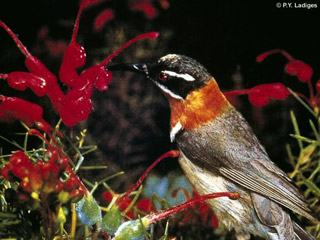Pollination: Grevillea and Eucalyptus
Many other plants have evolved strategies to encourage animals, especially insects and birds,
to travel from plant to plant and in doing so transfer pollen.
In most instances the offering of a food reward is the fundamental attraction.
This reward may be the pollen itself or it may be nectar.
As the animal seeks out the food, its body brushes the sexual parts of the flower.
Many animals and flowering plants have co-evolved to maximise cross-pollination success;
in the plants this is most obviously seen in the shapes, coloration, marking and clustering of the flowers.
Cross-pollinating species have also evolved various mechanisms to prevent self-pollination.
Family Proteaceae provides many examples of pollination by birds and mammals. An example is shown in this photograph.

Honeyeater with pollen dabbed on its forehead by the pollen presenter (actually the style and stigma) of a species of Grevillea. Some time later the stigma of this flower will become receptive (ready to receive pollen).
